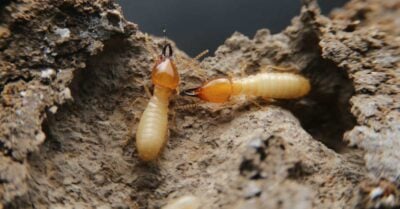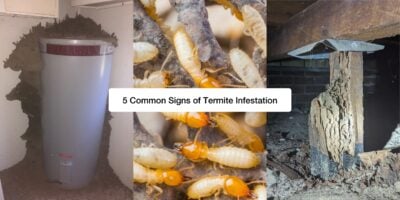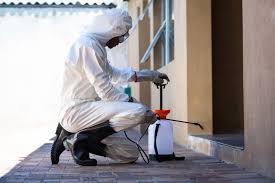 Frequently Asked Question
Frequently Asked Question
 Completely
Completely
Australian Run
 Mention this Ad & Get
Mention this Ad & Get
10% discount off any job
 Subterranean Termites: The Hidden Threat to Your Property
Subterranean Termites: The Hidden Threat to Your Property
Subterranean termites are a major concern for homeowners and property managers alike. Known for their ability to cause significant damage to structures, these pests are particularly notorious because of their underground behaviour, which makes them difficult to detect until extensive damage has already occurred.
What Are Subterranean Termites?
Subterranean termites are a species of termite that primarily live underground, creating extensive colonies with multiple nesting sites. These termites thrive in moist environments and are typically found in the soil. Unlike drywood termites, which live within wood, subterranean termites require contact with soil to survive and build their colonies.

Biological Characteristics of Subterranean Termites
Subterranean termites are social insects, living in large colonies that can contain millions of individuals. These colonies are divided into various castes, each with a distinct role:
- Workers: These are the termites responsible for feeding and maintaining the colony. They forage for wood, which they break down with the help of symbiotic bacteria in their gut.
- Soldiers: Soldier termites protect the colony from predators, particularly ants. Their large heads and powerful jaws are designed to defend the colony at all costs.
- Reproductives: These are the termites responsible for breeding and expanding the colony. The queen can lay thousands of eggs daily, ensuring the colony’s continuous growth.
- Alates: These are the winged termites that are capable of leaving the colony to form new colonies, a process known as swarming.
How Subterranean Termites Damage Your Property
Subterranean termites cause damage by consuming wood, primarily in the form of cellulose, which is found in the structure of most building materials. The damage they cause can be severe, often leading to costly repairs. Here are some of the primary ways they damage properties:

Structural Damage
Subterranean termites consume wood from the inside out, leaving a thin layer of wood on the exterior. This type of damage can be difficult to detect until it becomes extensive. Commonly affected areas include beams, joists, and flooring. Over time, the structural integrity of the building is compromised, which can lead to collapse in severe cases.
Electrical Hazards
Termites can also damage electrical wiring within walls, potentially creating short circuits or even fires. They often travel through insulation in search of wood, and while doing so, they may chew through wires, posing a serious risk to the property’s occupants.
Foundation Damage
The tunnels created by subterranean termites can also compromise the foundation of a building. These termites often enter homes through cracks or gaps in the foundation, which allows them to access the wood framing of the structure. This hidden infestation can lead to major foundation issues if left untreated.
Signs of Subterranean Termite Infestation
Recognising the signs of a subterranean termite infestation is crucial in preventing further damage. Some common indicators include:
- Mud Tubes: Subterranean termites build mud tubes to travel between their colony and food source. These tubes are typically found along foundation walls, in crawl spaces, or under flooring.
- Hollow-Sounding Wood: If you tap on wooden structures like beams or walls and they sound hollow, this is a strong indicator that termites are feeding inside.
- Swarmers: Winged termites, or swarmers, often appear around windows or light sources during mating season. This is a sign that a colony is present and potentially causing damage.
- Bubbling or Peeling Paint: Termite activity can cause the paint on wooden surfaces to bubble or peel, as moisture from their tunneling affects the surface.
Preventing Subterranean Termite Infestation
Taking proactive measures to prevent subterranean termite infestations is essential to protecting your property. Here are some effective prevention strategies:
1. Remove Wood and Debris
Termites are attracted to wood and debris. Ensure that wood piles, tree stumps, and other organic materials are removed from around your home. Keep firewood stored at least 20 feet away from the house.
2. Address Moisture Issues
Subterranean termites require moisture to survive. Fix any leaky pipes, clogged gutters, or other sources of excess moisture around your home. Consider installing a dehumidifier in damp areas like basements and crawl spaces to reduce moisture levels.
3. Install a Physical Barrier
Install a physical barrier around your home to prevent termites from entering. This can include sand barriers or steel mesh, which make it difficult for termites to access your home from the soil.
4. Regular Inspections
Regular termite inspections are key to detecting early infestations before they cause significant damage. Hiring a BugFree pest control professional to inspect your home annually can help catch problems before they escalate.
Treatment Options for Subterranean Termites
Once subterranean termites have infested a property, it’s essential to act quickly to eliminate them. There are several termite treatment methods available:

1. Liquid Termiticides
Liquid termiticides are applied around the perimeter of the home or directly into the soil. These chemicals create a barrier that prevents termites from entering or exiting the treated area. The most commonly used termiticides include fipronil, imidacloprid, and chlorpyrifos.
2. Baiting Systems
Termite baiting systems are an environmentally-friendly alternative to liquid termiticides. These systems consist of bait stations placed around the property that contain slow-acting poison. When termites feed on the bait, they carry it back to the colony, eventually killing the entire population.
3. Fumigation
In severe cases of infestation, fumigation may be necessary. This method involves sealing the home in a tent and filling it with a gas that eliminates termites. Fumigation is highly effective, but it requires the home to be vacated for several days and may be more costly than other treatments.
4. Heat Treatment
Heat treatment involves raising the temperature inside the home to a level that is lethal to termites. This method can be effective but may not reach all the infested areas, making it necessary to combine it with other treatments.
How Bugfree Pest Control Can Help
Subterranean termites can cause severe and costly damage to your property, making early detection and effective treatment essential. Bugfree Pest Control is here to help safeguard your home or business from the destructive force of these pests. Our experienced team offers thorough termite inspections, customised treatment plans, and ongoing monitoring to ensure that your property remains termite-free.
If you suspect a termite problem or want to take preventive measures before an infestation occurs, don’t hesitate to contact Bugfree Pest Control today. With our advanced termite control solutions, we will provide peace of mind knowing your property is in safe hands.
Residential & Domestic
Professional services with affordable Prices
Our fully licensed and experienced technicians will provide you and your family members with a pest control treatment catered for you and your home.
Commercial Pest Control
100% environmentally safe and friendly
All our chemical treatments are approved under Australian Standards so you can be confident of a safe and quality outcome.





